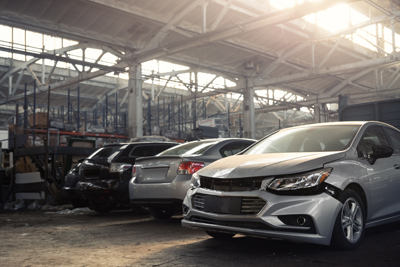Increased Cost to Repair Damaged Vehicles
Automakers are also incorporating more technology in their vehicles---things like automatic emergency braking, adaptive cruise control or L2 vehicle autonomy; connected car technology; and more. As more vehicles come equipped with this technology, vehicle repair cost and complexity grow.
More vehicle repairs include costs associated with vehicle scan and calibration, operations that have added $66 and $27 per claim respectively versus just $4 and $5 per claim in early 2017. More parts are replaced per repair, and more labor hours are needed---both have seen steady growth over time. Average repair costs have been climbing steadily for years, even when prior years’ average total cost of repairs are adjusted for inflation.
In fact, just taking the five-year average growth in labor hours, part replacements and frequency of scan and calibration per claim and assuming no increase in labor rates or part costs suggests repair costs could climb another 4% to 5% in 2023 versus 2022. Given the current and anticipated shortage of collision repair technicians and continued push by repairers to raise rates to help recruit more to the industry, labor rates will likely see further increases in 2023, and average cost of repairs may climb as much as 10% in 2023.
Advanced driver assistance systems (ADAS) in vehicles continue to proliferate. By Sept. 1, 2022, nearly all automakers have committed to minimally equip all vehicles of 8500 curb weight produced for the U.S. market with front crash warning and automatic emergency braking. As of Sept. 1, 2021, it’s estimated approximately 80% of the newest vehicles were already meeting that commitment.
As more vehicles come so equipped, many are also coming with additional ADAS technology like L2 autonomy (aka adaptive cruise control with lane keeping assist) which, unfortunately, data from IIHS and others shows may be leading drivers to take on more risk from speeding and distraction.
Additionally, real-world data on driver-assistance technology from IIHS/HLDI shows these systems help drive down frequency of low-value claims, but collision and property damage liability (PDL) average claim severities are shifted upward. For example, their analysis showed a nearly 40% drop in the frequency of PDL claims less than $1,500 involving an insured striking vehicle with AEB, and a more than 20% drop in the frequency of PDL claims costing between $1,500 and $6,999, pushing the average severity of all PDL claims up by nearly 20%.
Rising Insurance Premiums
In response to frequency continuing to climb to pre-pandemic levels and soaring loss costs, the auto insurance industry has been working to raise premiums. Comparison of the year-over-year increases in other CPI categories like used cars and trucks, motor vehicle body work, motor vehicle parts and equipment illustrates the challenge carriers face in responding to significant inflation affecting auto claims.
Higher Gas Prices
Last, but certainly not least, gas prices are also expected to remain elevated in 2023. While prices for gasoline have fallen from over $5 per gallon in June, the Energy Information Administration forecasts gasoline prices will average $3.57 per gallon in 2023, versus $2.78 per gallon in the first half of 2021. As miles driven in the U.S. build, and congestion levels grow, higher gas prices will drive down spending in other areas among most consumers.
2023 is shaping up to be another year where the expense of owning a vehicle won’t be cheap.
Source: CCC Intelligent Solutions, Inc.










Abby Andrews